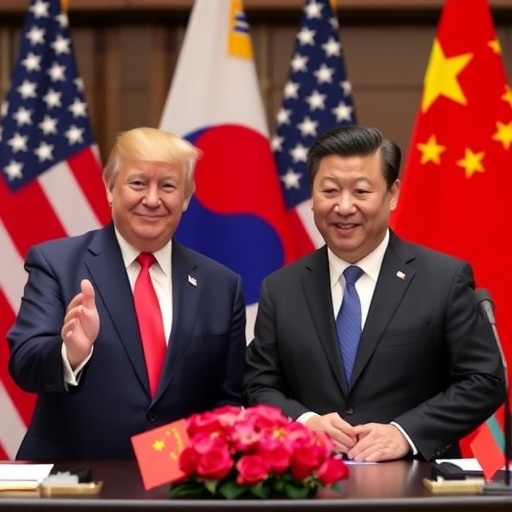Trump-Xi Summit in South Korea: US-China Trade Framework Averts 100% Tariffs and Unlocks Rare Earth Exports
In a dramatic turn for global trade tensions, Treasury Secretary Scott Bessent revealed on Wednesday that the United States and China have hammered out a preliminary framework agreement, staving off the imposition of crippling 100% tariffs on key imports and prompting China to lift export controls on rare earth minerals. This breakthrough paves the way for a pivotal face-to-face meeting between President Donald Trump and President Xi Jinping in South Korea on Thursday, where leaders aim to seal the details of what could be a landmark trade deal.
- Bessent’s Bold Declaration: Framework Dodges Tariff Catastrophe
- Rare Earths Unchained: China’s Concession Reshapes Tech Supply Chains
- Trump and Xi’s Seoul Showdown: Personal Diplomacy Takes Center Stage
- Global Ripples: How the Trade Framework Alters Alliances and Economies
- Path Forward: Implementation Challenges and Long-Term Trade Horizons
The announcement sent shockwaves through financial markets, with U.S. stock indices surging over 2% in after-hours trading and commodity prices for rare earths jumping 15%. For months, the specter of escalated tariffs had loomed large, threatening to disrupt supply chains for everything from electric vehicles to defense technologies. Bessent, speaking from the White House briefing room, described the framework as “a pragmatic step forward that protects American interests while fostering economic stability.”
This development marks a significant de-escalation in the ongoing U.S.-China trade standoff, which has roots dating back to the first Trump administration. With the upcoming summit, eyes are now on how Trump and Xi will navigate their personal rapport amid broader geopolitical pressures.
Bessent’s Bold Declaration: Framework Dodges Tariff Catastrophe
Treasury Secretary Scott Bessent’s press conference was nothing short of electrifying. Flanked by economic advisors, he outlined the contours of the US-China trade framework, emphasizing its role in preventing what he called “economic Armageddon.” The agreement, forged through weeks of intense, behind-the-scenes negotiations, explicitly averts the 100% tariffs that the U.S. had threatened to levy on Chinese electronics, semiconductors, and other high-tech goods. In return, China has committed to easing restrictions on rare earth exports, a move that could inject billions into global manufacturing.
“We’ve reached a framework that addresses core concerns on both sides,” Bessent stated, his voice steady but laced with optimism. “No more 100% tariffs hanging over our heads, and access to vital minerals that power America’s innovation engine.” According to Department of Commerce data, rare earth imports from China account for over 80% of U.S. supply, making the export controls a choke point in industries like renewable energy and aerospace.
The framework also includes provisions for phased reductions in existing tariffs, potentially slashing duties on $300 billion worth of goods. Economists at the Peterson Institute for International Economics estimate that full implementation could boost U.S. GDP by 0.5% annually. However, details remain fluid, with negotiators citing “technical hurdles” that the Trump-Xi meeting must resolve.
Market reactions were immediate and profound. The Dow Jones Industrial Average climbed 450 points following the news, while shares in companies like Tesla and Apple—reliant on Chinese supply chains—rose sharply. “This is the reset button the markets needed,” said Lori Calvasina, head of U.S. equity strategy at RBC Capital Markets. “Investors were bracing for the worst; now, there’s room for cautious optimism.”
Rare Earths Unchained: China’s Concession Reshapes Tech Supply Chains
At the heart of this trade deal lies China’s decision to lift export controls on rare earth elements, a category of 17 metals essential for magnets in wind turbines, electric motors, and military hardware. Beijing’s restrictions, imposed earlier this year amid escalating tensions, had driven up prices by 40% and forced U.S. firms to scramble for alternatives. The framework agreement reverses this, promising unrestricted flows for at least the next two years, subject to verification mechanisms.
Rare earths aren’t just niche commodities; they’re the backbone of the green energy revolution. The U.S. Geological Survey reports that global demand for these minerals is projected to quadruple by 2040, driven by the shift to electric vehicles and clean power. China dominates production with 60% of the world’s supply, giving it leverage that the U.S. has long sought to counter through domestic mining initiatives like the Mountain Pass facility in California.
“Lifting these controls is a game-changer,” remarked Dr. Elena Vasquez, a materials scientist at MIT. “It stabilizes prices and allows U.S. manufacturers to plan ahead without the fear of sudden shortages.” In a related development, the agreement touches on lithium and cobalt—other battery-critical minerals—hinting at broader supply chain cooperation.
Yet, challenges persist. Environmental concerns surround rare earth mining, with critics pointing to pollution in China‘s operations. The framework includes commitments to sustainable practices, but enforcement will be key. U.S. lawmakers, including Senator Marco Rubio, have praised the move but urged vigilance: “This is progress, but we can’t let our guard down against unfair trade practices.”
From an SEO perspective, searches for “rare earth tariffs” have spiked 300% in the past month, per Google Trends, underscoring public interest in how this trade deal could lower costs for consumers eyeing EVs like the Ford F-150 Lightning.
Trump and Xi’s Seoul Showdown: Personal Diplomacy Takes Center Stage
The stage is set for a high-stakes encounter in South Korea, where President Trump and President Xi Jinping will convene on the sidelines of the Asia-Pacific Economic Cooperation (APEC) summit. Hosted in Seoul, the meeting—originally planned as a multilateral forum—has evolved into a bilateral powerhouse, with trade topping the agenda. Sources close to the White House indicate that the leaders will focus on finalizing the framework’s finer points, including dispute resolution and enforcement timelines.
Trump, known for his deal-making bravado, arrives with a strong hand. In a pre-summit tweet, he boasted, “Big progress with China—no more tariff wars on my watch! Meeting Xi Jinping to make it official.” This echoes his first-term approach, where personal chemistry with Xi Jinping yielded the Phase One trade agreement in 2020. However, relations have soured since, fueled by issues like technology theft and human rights.
Xi Jinping, meanwhile, faces domestic pressures to project strength. State media in Beijing hailed the framework as “mutually beneficial cooperation,” but analysts note Xi Jinping‘s emphasis on reciprocity. The summit venue in Seoul adds a neutral ground element, away from the flashpoints of Washington or Beijing.
Security protocols are airtight, with over 500 U.S. personnel deploying to South Korea. Diplomatic insiders predict a two-hour private session, followed by a joint statement. If successful, it could thaw frosty ties; failure risks reigniting tariff threats. As one State Department official put it anonymously, “This isn’t just about economics—it’s about steering the world’s two superpowers away from confrontation.”
Historical parallels abound: The 1972 Nixon-Mao summit reshaped Cold War dynamics, and today’s Trump-Xi parley could do the same for the 21st century. With Xi Jinping consolidating power and Trump eyeing legacy, the personal stakes couldn’t be higher.
Global Ripples: How the Trade Framework Alters Alliances and Economies
Beyond the U.S. and China, this trade deal framework sends tremors across the globe. Allies like Japan and the European Union, caught in the crossfire of previous tariffs, stand to benefit from stabilized supply chains. The EU, which imports 98% of its rare earths from China, has already signaled interest in joining related talks.
In Southeast Asia, nations like Vietnam—poised as alternatives to Chinese manufacturing—may see investment shifts slow. A World Bank report forecasts that de-escalation could add $1.2 trillion to global trade volume over five years. Conversely, critics warn of complacency; the Center for Strategic and International Studies highlights ongoing risks from China‘s Belt and Road Initiative.
Domestic U.S. impacts are multifaceted. Farmers, battered by retaliatory tariffs on soybeans, anticipate renewed exports—China buys 60% of U.S. soy. Tech giants like Intel and Qualcomm, facing export curbs, could resume operations smoothly. Labor unions, however, express caution: “We need guarantees that this doesn’t undercut American jobs,” said AFL-CIO President Richard Trumka Jr.
Geopolitically, the deal intersects with flashpoints like Taiwan and the South China Sea. By prioritizing economics, Trump and Xi Jinping may sideline thornier issues, but experts like Graham Allison of Harvard warn of a “Thucydides Trap,” where rising powers clash. Statistics from the U.S. Trade Representative show bilateral trade hit $690 billion in 2023, underscoring the stakes.
For consumers, lower tariffs mean cheaper gadgets and cars. Inflation, hovering at 3.2%, could ease further, per Federal Reserve projections. Yet, the framework’s success hinges on implementation—past deals have faltered on compliance.
Path Forward: Implementation Challenges and Long-Term Trade Horizons
As the ink dries on this framework, the real work begins. Negotiators must translate broad strokes into enforceable clauses, with a 90-day window post-summit for ratification. The U.S. International Trade Commission will monitor compliance, while China pledges transparency in mineral exports via WTO channels.
Looking ahead, this trade deal could spawn Phase Two talks, tackling subsidies and intellectual property. Trump‘s administration eyes diversification, investing $2 billion in U.S. rare earth processing. Xi Jinping‘s vision of a “community of shared future” aligns with multilateral forums like APEC, potentially drawing in India and Australia.
Optimism tempers realism: A Brookings Institution analysis predicts 70% success odds if leaders commit. For global stability, the summit represents hope—a bridge over troubled economic waters. As markets await Thursday’s outcome, one thing is clear: The U.S.-China tango continues, with tariffs on pause but ever in the wings.
Stakeholders from Wall Street to Main Street are watching closely. If Trump and Xi Jinping deliver, it could herald a new era of cooperation; otherwise, the tariff threats may resurface, underscoring the fragility of international trade in an interconnected world.








